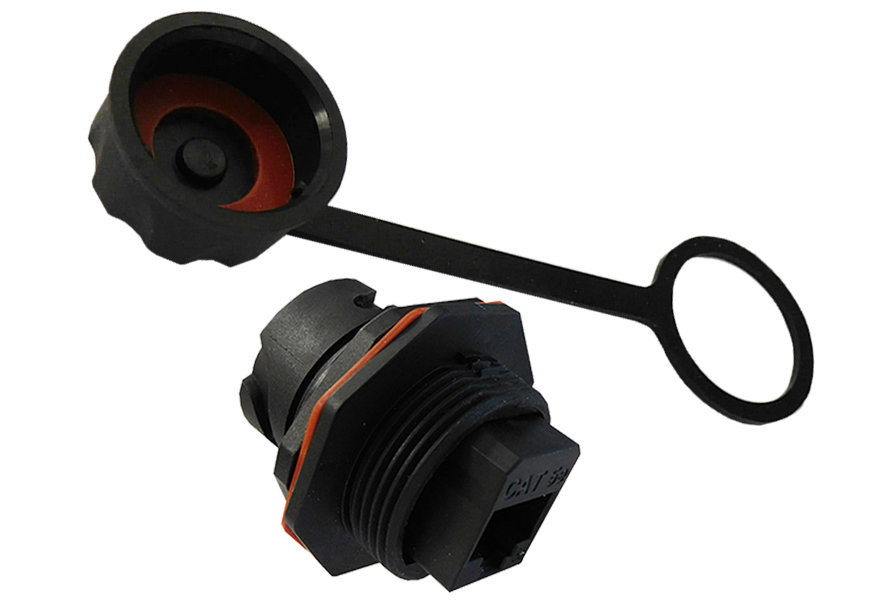RJ45 Ethernet Connectivity Requirements for IoT Devices
Ruggedized RJ45 plugs meet IEC 60603-7 standards, enduring vibrations, extreme temperatures, shocks, and liquid exposure. Ideal for harsh environments.
下载 PDFIntroduction to IoT and Ethernet Connectivity
With the increasing prevalence of smart homes, buildings, factories, and cities powered by the Internet of Things (IoT), Ethernet connectivity has become essential for devices that once lacked advanced communication capabilities.
As we know, the IoT uses Ethernet connectivity to control and monitor devices via the internet using smart phones, tablets, PCs and many more types of devices. The globally accepted standard connector interface for Ethernet connectivity has been the RJ45 but this was originally designed for connectivity that is in an indoor, controlled environment. As the inevitable spread of the IoT continues, more and more devices can be found in harsh outdoor and demanding indoor environments and this development has driven the need for RJ45 connectors that are ruggedized for these new types of applications.
The Importance of RJ45 Connectors in IoT
The issue is even more pronounced with the Industrial Internet of Things (IIoT) where connectivity is required in some of the most difficult environments, enabling cables to transport data to and from connected devices at ever-increasing speeds. In more and more industrial situations, Ethernet is replacing a popular range of industrial networks that are simply incapable of delivering massive amounts of data at the speeds that are now required. However, in recent years, there has been discussion around the idea that RJ45 connectors are insufficiently robust for harsh and demanding industrial applications and that M12 Ethernet connectors represent a far better option. This school of thought ignores the fact that the humble RJ45 has undergone something of an upgrade – if not a major transformation – that makes it far more suitable for IoT (and even IIoT) applications than was previously the case.
Reliability of Network Connections
Whatever type of connection a network uses, the most important factor has always been reliability and it can be argued that any network is only as good as its weakest connection. Reliability becomes even more crucial as the number of devices, sensors and pieces of equipment communicating over increasingly complex networks increases. It would certainly be a mistake to dismiss the RJ45 8-pin connector as old technology or not fit for connectivity in the 21st century. On the contrary, close inspection of ruggedized RJ45 plugs such as those from Stewart Connector – as well as a range of jacks and cable assemblies designed specifically for IoT applications – shows that they not only conform to the IEC 60603-7 standard but they can also withstand vibrations, widely varying temperatures and shock as well as close proximity to various types of liquid. These IP68-rated sealed RJ45 units are also capable of supporting Ethernet connectivity at speeds from 1Gigabit per second up to 10GB/s.
Applications of Ruggedized RJ45 Connectors
These credentials make the connectors ideal for applications in sectors such as energy, utilities, WiFi, cellular, farming, security, lighting, factories, healthcare, metering and transportation. In such areas there could be catastrophic consequences should the Ethernet connectivity cease to operate, which would inevitably require a service technician to be sent out to resolve the issue. The cost and time involved in firstly identifying the problem and then fixing it would be nothing compared to the knock-on effects of connectivity disruption.
Changing Perceptions of RJ45 Connectors
To this end, the modern engineer may need to adjust his or her understanding of RJ45 connectors and their apparently inherent limitations. Instead of thinking that RJ45 connectors need to be protected or are only suitable for fitting in cabinets and other enclosed areas, engineers should open up their minds to the many advantages that today’s ruggedized connectors offer, most notably the ability to deliver data rapidly without the need for any adaptor cables. Other benefits, of course, include ease of use (it is simplicity itself to connect or disconnect an RJ45), the ability to operate in conjunction with 2- and 4-pair wiring systems, and the fact that these connectors are fitted so extensively around the world.
An example of one such product is Stewart Connector’s RJ45 D38999, which is designed to provide Ethernet connectivity in outdoor and harsh environments. The connector was developed with recognition that Ethernet had moved beyond the office environment into industrial applications, where it is important to have a sealed but reliable cable assembly to transmit data. Combining a rugged series III style shell with a high performance RJ45, this connector ensures EMI protection through its shielded cable and offers a footprint that is the smallest available to date. However, despite its compact design this size 17 connector can be used to transmit communications through 10Base-T, 100Base-T and 1G Base-T Ethernet, with high performance connectivity up to 100 MHz. Offering a minimum of 500 mating cycles and produced in a variety of metals and plating options, the connector is available with four keyways.
The SealJack Range
Complementing these rugged RJ45s is the SealJack range of vertical modular jacks that offer protection against moisture and other environmental factors that can have such a detrimental effect on the capabilities of electronic systems. Based on the reliability of Stewart Connector’s RJ45 jack, the SealJack incorporates a sealed IP67- rated housing in zinc die cast alloy with nickel plating that delivers reliable connectivity. The unit is also the lightest and most compact on the market that is capable of supporting 10/100Base-T, 1G Base-T, and 10G Base-T Ethernet (with optional support available for CAT5E and CAT6A premise wiring systems).
Image 1: SealJack™ 板载连接器

The SealJack can be supplied in single-port vertical format or in a four-port vertical harmonica jack configuration which is lighter and smaller in volume and area than other similar units. Offering port density volume of 2.3 ports per in3, these RJ45 jacks deliver at least 750 mating cycles and include a gasket that allows for front or rear panel mounting (multiple LED configurations are also available). With the option of an EPP 918-A protective coating, the SealJack units are RoHS compliant and compatible with the very latest Power over Ethernet (PoE+) standard – delivering up to 30W of power per device.
Protection Against Environmental Factors
Also designed for use with ruggedized RJ45 connectors in the harshest of environments is Stewart Connector’s SealJack cable applied jacks. As with the products mentioned above, the watchwords for this sealed yet reliable and versatile connector system are reliability and functionality – which again means protection against moisture and other potentially damaging environmental factors, with a sealable cap for IP67 applications to IEC 60529 specifications when not in use.
Image 2: SS-60300-025 IP67 Coupler

Based on Stewart Connector’s RJ45 modular plugs and jack coupled with a sealed IP67 shell design, the SealJack assembly and jack combination is also available for CAT5E and CAT6 applications and in shielded and unshielded configurations. Also RoHS compliant and supporting POE+, as well as 10/100Base-T, 1G Base-T, 2.5G Base-T, and 5G Base-T Ethernet. Other features include a circular bayonet style coupling for consistent sealing and ease of use, with panel mounted jacks incorporating a punch down block to simplify cable termination. In addition, field termination plug kits available include an IP67 rated shell and modular RJ45 plug while the cable assemblies can have dual or single IP67 rated plug terminations.
The Future of IoT and IIoT Connectivity
It’s clear, then, that RJ45 connectors have moved on considerably in recent times and are now tough enough and reliable enough for the most demanding applications – indoor and outdoor – that are involved in successful implementation and operation of the IoT and IIoT.

Explore Our SealJack™ RJ45 Couplers
了解更多
